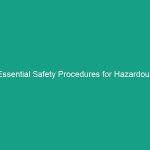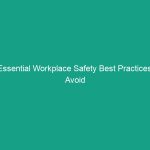Introduction
Good morning team! Today, we’re diving into an essential aspect of our Workplace Safety: Essential Guidelines for Safe and Effective Pressure Regulation. This topic is crucial because improper pressure regulation can lead to significant Hazards, from equipment failure to serious injuries. Understanding these guidelines not only protects you but also ensures that we maintain a safe and efficient working Environment for everyone.
Understanding Pressure Regulation
Pressure regulation refers to the methods and practices used to manage and control the pressure of gases or liquids within systems. Proper pressure regulation is vital in various industries, including manufacturing, oil and gas, and chemical processing. It directly impacts our daily operations, influencing everything from equipment efficiency to worker Safety.
Many employees believe that pressure regulation is solely the responsibility of engineers or technicians. However, every team member plays a role in maintaining safe pressure levels, and awareness of these guidelines is key to preventing accidents.
Key Hazards, Risks, and Safety Considerations
When it comes to pressure regulation, there are several hazards and risks involved:
- Overpressure: Excessive pressure can lead to equipment rupture, causing spills or explosions.
- Underpressure: Insufficient pressure may cause systems to malfunction, leading to inefficient operations and potential hazards.
- Material Failure: Inappropriate materials used in pressure systems can degrade and fail under stress.
- Human Error: Incorrect adjustments or lack of understanding can lead to dangerous situations.
Ignoring these safety protocols can have real-world consequences, including injuries, loss of life, and significant financial costs due to equipment damage and downtime. We must take these risks seriously and adhere to established Safety Measures.
Best Practices, Procedures, & Actionable Advice
To ensure safe and effective pressure regulation, here are some Best Practices:
- Regular Training: Participate in regular training sessions to stay updated on safety protocols. Knowledge is power!
- Routine Inspections: Conduct routine inspections of pressure systems to identify any signs of wear and tear.
- Use Proper Equipment: Always use the correct gauges, valves, and regulators designed for the specific pressure range of your system.
- Document Everything: Keep accurate records of pressure readings and Maintenance checks to track performance and safety compliance.
For instance, a manufacturing plant experienced a severe incident when an employee failed to notice a faulty pressure gauge. The result was an explosion that could have been easily prevented with regular checks and proper training. Case studies like this serve as a reminder of the importance of vigilance and adherence to safety protocols.
Regulations, Standards, and Compliance
Compliance with safety Regulations is crucial for the safety of all employees. Here are a few Standards that guide pressure regulation:
- OSHA Standards: The Occupational Safety and Health Administration sets forth regulations to ensure Workplace Safety.
- ISO Standards: The International Organization for Standardization provides guidelines on quality and safety management.
- Company-Specific Policies: Always adhere to our internal safety protocols and Procedures to maintain compliance.
Understanding and complying with these regulations is not just about following rules; it’s about protecting yourself and your colleagues. Non-compliance can lead to severe penalties and, more importantly, unsafe working conditions.
Employee Engagement & Discussion
Let’s take a moment to engage in a discussion. Think about your experiences with pressure regulation:
- What safety challenges have you encountered related to pressure regulation?
- How do you think we can improve our current pressure management practices?
- Have you seen any near-misses that we should learn from?
Your insights are invaluable, and sharing them can help us create a safer environment for everyone. Remember, safety is a collective responsibility!
Conclusion & Key Takeaways
In conclusion, adhering to the Essential Guidelines for Safe and Effective Pressure Regulation is critical for our safety. Here are the key takeaways:
- Understand the importance of pressure regulation in your daily tasks.
- Be aware of the potential hazards associated with improper pressure management.
- Follow Best Practices and procedures to ensure safety.
- Stay informed about regulations and compliance standards.
- Engage in discussions and share your experiences to enhance Workplace Safety.
Thank you for your attention and commitment to safety. Remember, by prioritizing these practices, we can create a safer workplace for everyone. Let’s work together to ensure that we all return home safely each day!


